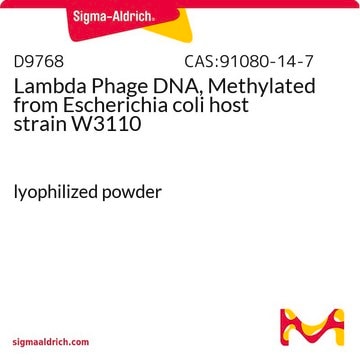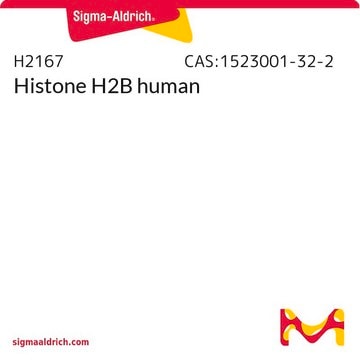10223565001
Roche
Histone
from calf thymus
Synonym(s):
histone
Sign Into View Organizational & Contract Pricing
All Photos(1)
About This Item
UNSPSC Code:
12352204
Recommended Products
Quality Level
form
lyophilized
packaging
pkg of 10 mg
manufacturer/tradename
Roche
shipped in
wet ice
storage temp.
2-8°C
Related Categories
General description
Mixture of histones H1, H2A, H2B, H3, and H4, isolated from calf thymus.
Histones are a group of DNA-binding proteins that are characterized by relatively high levels of lysine and arginine. Five different fractions of histones have been isolated and characterized. These are named as H1, H2A, H2B, H3 and H4. The H1 fraction is lysine-rich, while the H2A and H2B are slightly lysine-rich, The H3 and H4 fractions are arginine-rich. The molecular weights of histones are approximately 11 to 21 kDa depending on the fraction.
Histones are a group of DNA-binding proteins that are characterized by relatively high levels of lysine and arginine. Five different fractions of histones have been isolated and characterized. These are named as H1, H2A, H2B, H3 and H4. The H1 fraction is lysine-rich, while the H2A and H2B are slightly lysine-rich, The H3 and H4 fractions are arginine-rich. The molecular weights of histones are approximately 11 to 21 kDa depending on the fraction.
Application
Histone from calf thymus has been used:
- in in vitro kinase assay to check the phosphorylation of histones by protein kinase A.
- to check the in vitro methyltransferase activity of protein argininemethyltransferases from Oryza sativa (OsPRMTs).
- in anti-histone ELISA.
Biochem/physiol Actions
Histones have an important role in the organization and modification of chromatin. The nucleosome is the basic unit of the chromatin. It is made up of two molecules each of histones H2A, H2B, H3 and H4, wrapped with approximately 146bp of DNA. Histone H1 binds to the nucleosomes at the DNA entry and exit points and stabilizes them.
Physical form
Lyophilizate (natural mixture of histones H1, H2A, H2B, H3, and H4).
Preparation Note
Working concentration: 1 to 5 mg/ml.
Working solution: Recommended solvent is double-distilled water.
Storage conditions (working solution): Aqueous solution is stable at -15 to -25 °C for several months.
Avoid repeated freezing and thawing!
Working solution: Recommended solvent is double-distilled water.
Storage conditions (working solution): Aqueous solution is stable at -15 to -25 °C for several months.
Avoid repeated freezing and thawing!
Other Notes
For life science research only. Not for use in diagnostic procedures.
Storage Class
11 - Combustible Solids
wgk_germany
WGK 1
flash_point_f
Not applicable
flash_point_c
Not applicable
Certificates of Analysis (COA)
Search for Certificates of Analysis (COA) by entering the products Lot/Batch Number. Lot and Batch Numbers can be found on a product’s label following the words ‘Lot’ or ‘Batch’.
Already Own This Product?
Find documentation for the products that you have recently purchased in the Document Library.
Customers Also Viewed
Abinaya Rajendran et al.
Biochemistry, 59(2), 183-196 (2019-09-04)
The metabolic serine hydrolase family is, arguably, one of the largest functional enzyme classes in mammals, including humans, comprising 1-2% of the total proteome. This enzyme family uses a conserved nucleophilic serine residue in the active site to perform diverse
Ona Bloom et al.
Proceedings of the National Academy of Sciences of the United States of America, 108(25), 10255-10259 (2011-06-08)
Systemic lupus erythematosus (SLE) is a chronic autoimmune disease characterized by the presence of pathogenic autoantibodies, many of which are directed against nuclear antigens, in particular double-stranded (ds) DNA. Both clinical studies and animal models have shown that anti-dsDNA antibodies
H1 histone and the condensation of chromatin and DNA.
R D Cole et al.
Cold Spring Harbor symposia on quantitative biology, 42 Pt 1, 253-263 (1978-01-01)
Nicole Happel et al.
Gene, 431(1-2), 1-12 (2008-12-09)
The lysine-rich H1 histone family in mammals includes eleven different subtypes, and thus it is the most divergent class of histone proteins. The central globular H1 domain asymmetrically interacts with DNA at the exit or entry end of the nucleosomal
Core histones H2B and H4 are mobilized during infection with herpes simplex virus 1.
Conn KL, et.al
Journal of Virology, 85(24), 13234-13252 (2011)
Our team of scientists has experience in all areas of research including Life Science, Material Science, Chemical Synthesis, Chromatography, Analytical and many others.
Contact Technical Service










